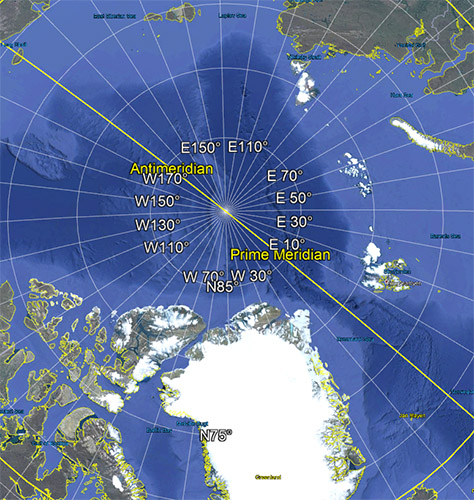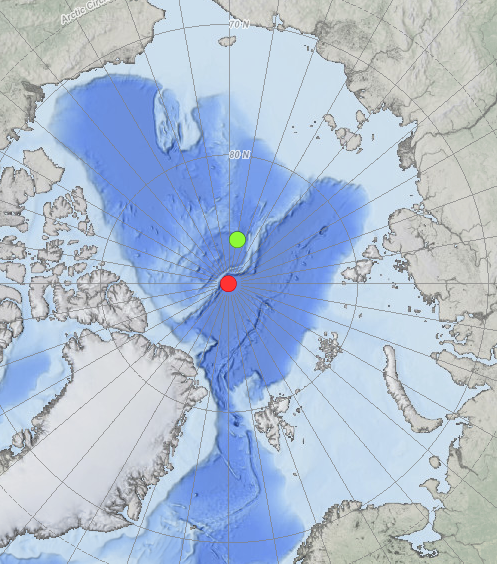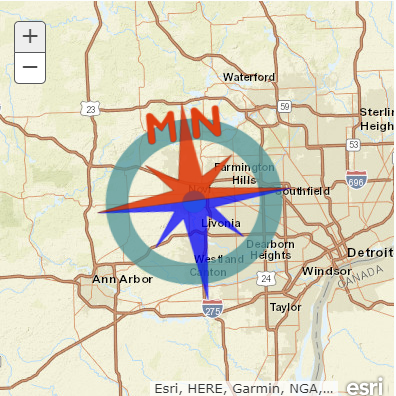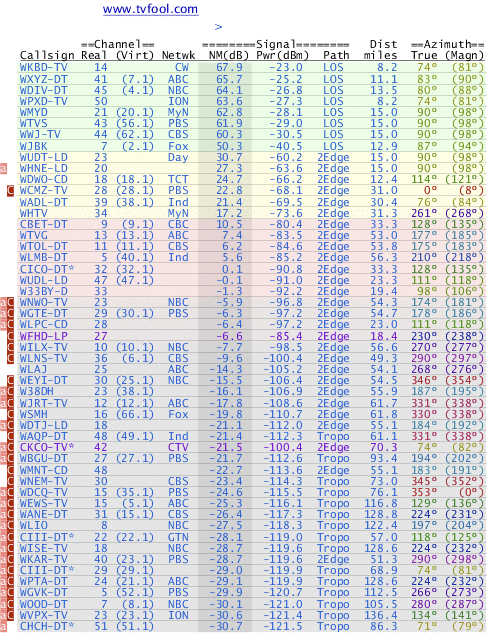This question came to us courtesy of social media. It’s one with a lot of parts that need answering, and as they often say on the news, “the answer may surprise you.” But, I’ll save that answer for the end of the article. In order to really understand what’s being asked, you need to have some other information.
What is “true north?”

Ask any elementary school student who’s been paying attention in class, and they’ll tell you that true north and true south define the Earth’s axis. In other words, the planet spins around as if it were on a long rod. Where that rod touches the surface of the planet is true north, and true south. The map above has a white dot where true north is.
Except of course, that isn’t really accurate.
It was accurate and potentially will be accurate again. But the actual axis of the Earth moves. Not much. The Earth’s axis is somewhere around 100 feet away from the geographic North Pole. Not so much that anyone would really worry.
When mapmakers started to really get serious, they figured out where they thought the true North Pole was. And then literally every map made since has agreed, that’s where it is. Imagine the chaos if new maps came out every time they measured the Earth’s axis. They wouldn’t be off by much, just enough to make for huge chaos.
What is “magnetic north?”

The Earth, like practically all celestial bodies, has a magnetic field. This magnetic field is pretty helpful for the planet, and as humans we’ve discovered that if you put a magnet in a weightless and frictionless environment it will always point toward the north end of the magnetic field. (What I’ve just described, if you couldn’t figure it out, is a compass.)
Magnetic north wanders a lot. Right now it’s about 200 miles from true north. In the map above, true north is red. Magnetic north is green.
Declination

Declination is the difference between magnetic north and true north. In this map you can see that magnetic north lies about 7 degrees west of true north at our Novi office. Folks on the West Coast will find it’s more like 14 degrees east of true north. Because magnetic north and true north are so far away from each other, there’s going to be a difference depending on where you are.
Luckily you can use a tool like this one to get accurate readings of declination if you want them.
What this has to do with antennas

The first step in aiming an antenna is to figure out where you are in relation to the antennas. You can do this with a paper map, or with Google Maps or Google Earth. Tools like tvfool.com make it pretty brainless by providing you both magnetic north and true north numbers. (This list is for our headquarters in Novi, Michigan.)
Magnetic north or true north?
Your compass points to magnetic north. This is true whether you’re using one of those old-school ones or the compass in your phone. So should you be aiming based on magnetic north, or true north? The real answer is…
It doesn’t matter.
That’s right. In general it makes not one bit of difference whether you’re aiming based on magnetic north or true north when you aim your antenna. And when I explain why, you’ll agree with me.
Beam width
The biggest point here centers around beam width. Beam width, as I explain in this article, describes how far off a “perfect aim” an antenna can be and still pick up signals as well as it would in a perfect aim.
Most antennas have a beam width around 30-45 degrees. In other words, you can be off by 15-22 degrees in either direction and still get strong signals. Long-range antennas tend to have smaller beam widths so they can get weaker signals that they’re aimed right at.
Since the difference between magnetic north and true north isn’t more than 15 degrees, then it doesn’t matter if you’re aiming using magnetic north, even if your map is computed using true north.
Compass aiming is just the beginning.
Or at least it should be. You should always start by roughing in your aim with a compass or phone app, but then you should fine tune the aim by using a signal meter or the meter on your TV. This signal meter is fairly inexpensive and easy to use, and unlike really cheap meters it tells you all the information you need. Cheap signal meters don’t give you signal-to-noise ratio, which is incredibly important when aiming. Whether you start your rough aim with magnetic north or true north, you should always make little adjustments to help you get the strongest picture possible.
Get the antenna you need from Solid Signal
No matter if you’re 5 miles from the towers or 50 miles (or even more), you’ll find the best selection of antennas anywhere when you shop at Solid Signal. If you need help choosing the right antenna, fill out this form and a real, certified technician will review your information and suggest the best antenna for you!





